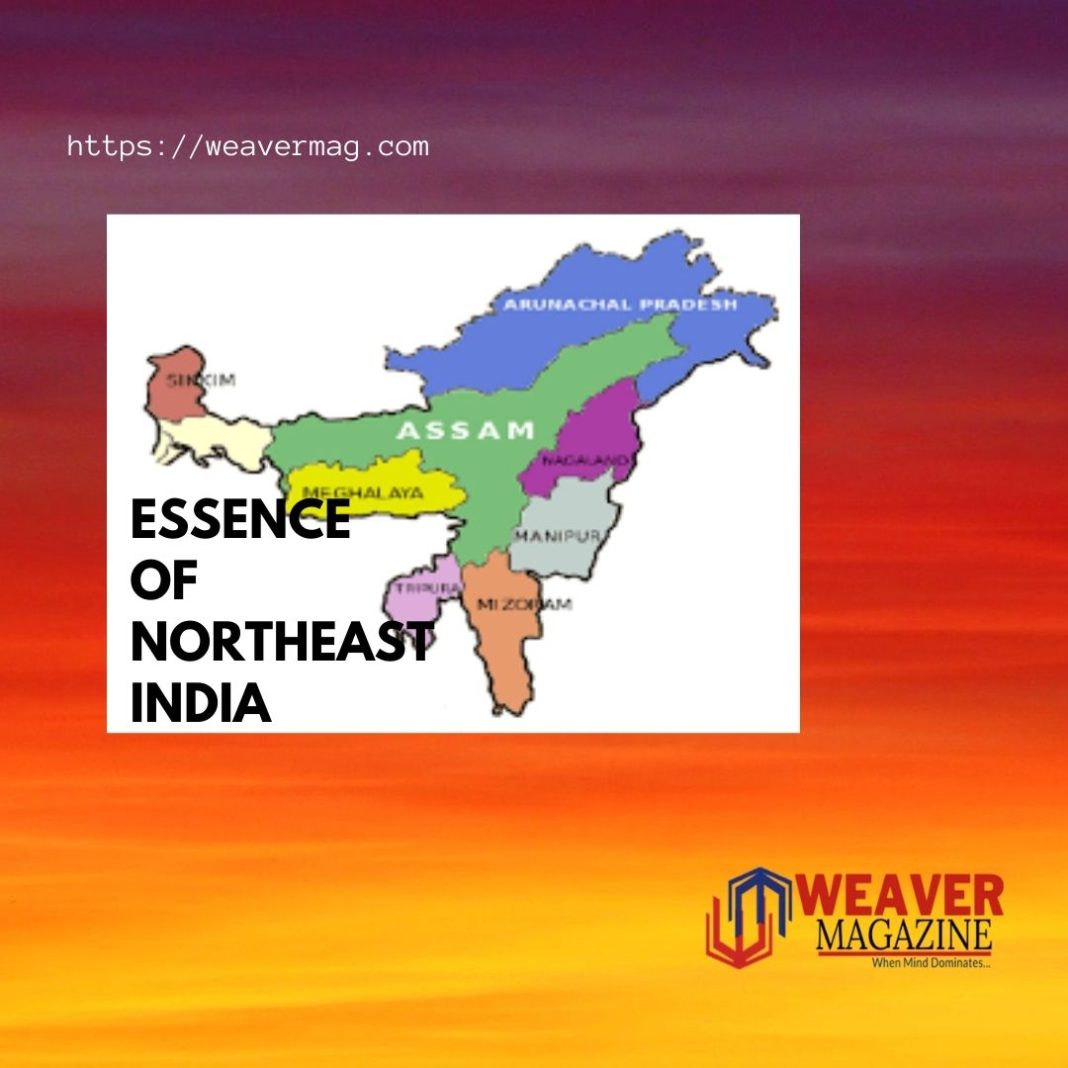What is the first thing that comes into your mind when you hear about Northeast India or the Seven Sister States of India? For many people from the National and International viewpoint, Northeast India is defined as the region of diverse and magnificent culture endowed with ethnic and enchanting land of great warriors. The unexplored paradise and hidden treasure of nature engulfed with mesmerizing nature’s beauty, distinct culture, diverse traditions, and Mongolian race– all these make the region unique.
With an area of 262,179 km², the region is located in the easternmost region of India sharing an international border with China, Myanmar, Bangladesh, Bhutan, and China. The contiguous states of Seven Sisters namely – Nagaland, Assam, Manipur, Meghalaya, Mizoram, Tripura, and Arunachal Pradesh and Sikkim (One brother) are solidarity bonded, uprooted, and mostly interdependent with nature. The region is moderate throughout the year and also receives average annual rainfall precipitation of 2,000 mm suitable even for the sustenance of ethnic biodiversity. One of Asia’s largest Church called Sumi Baptist Church with a capacity of 10,000 people is also located in one of the Seven Sister states called Nagaland. One of India’s longest bridges called Dhola Sadiya (Bhupen Hazarika bridge) connecting Assam and Arunachal Pradesh is also located in Northeast India. Do you know where the Kanchenjunga peak is located? Well, one of the third highest mountain peak in the world called Kanchenjunga (8,586 meters) is located in the North-eastern state (Sikkim) of India. Brahmaputra River (6,418 km) one of the third-longest rivers in the world is also located in Assam. One of the world’s wettest place called Mawsyrnam with an average annual rainfall of 11,872 mm is also located in the Khasi Hills of Meghalaya. Northeast India is also rich in many undiscovered and unutilized resources and the region is also known for the largest producer of tea in India. Northeast India not only contributes to the nation economically but also contributes various commodities to the outside world.
Biodiversity:
Northeast India is also rich in a biologically diverse ecosystem and has been an attraction for tourists since the past decades. The species found in the region are so rare that such flora and fauna are nowhere to be found in the rest of the world. Most of the region is also gentle and quiet away from hustle bustle transportation and the myriad crowd which makes the species to move freely away from danger. Many international organizations have also identified NE India as the hotspot for rice Germplasm (by Indian Council of Agricultural Research), Ecotourism by the World Wide Fund for Nature, and the region rich in wild relatives of crop plants by the National Bureau of Plant Genetic Resource.
The region is the abode place for many mysterious and an abundant flora flourishing in every region and making the place a paradise land like that in a TINKER BELL movie. Numerous endemic floral species are still unexplored and are also protected from human intervention. From the plains and vales of Assam to the hilly areas Arunachal Pradesh, the region is mostly covered with green patches of evergreen rainforest. Some regions are also covered with semi-evergreen forest, moist and deciduous forest, swampy, and grasslands. Khonoma (a village in Nagaland) is designated as Asia’s first Green village because of the utmost initiative of the tribal people of Khonoma residents for conserving the region to protect biodiversity from further danger. The region is also endowed with abundant rare species of different important medicinal plants. Tribal people traditionally utilize those medicinal plants as natural drugs to heal and cure diseases.
The region is mostly located near the Tropic of Cancer and that is the reason why the latitudinal contribution of aves, mammals, and insects is abundant. The favorable climate and biomes make the Northeast one among the unique region of the world. Many rare and endemic species such as One Horned Rhinoceros, Red Panda, Mithun, Gaur, Clouded Leopard, Sangai, Bugun Liocichla, Black-breasted Parrotbill Hornbill, Hoolock Gibbon, Gayal, Phayre’s Langur, etc. are some of the rarest species found only in Northeast India. Every year, thousands and thousands of Amur Falcon stopover at Doyang river (Nagaland), and thus, Nagaland state is also known as the Falcon Capital of the world.
Unfortunately, due to the emergence of human civilization, global warming, increasing human population, pollution, poaching and hunting, mining activities, and practice of shifting cultivation, near-human inhabit regions of biodiversity are hampering at a large extend. Many regions are already defiled, many species are extinct and many species are also on the verge of extinction. But, at the same time, inhabitants of the Northeast region are mostly interdependent on nature and it is their backbone for food, uprooted nature-based festivals, and many natural related immemorial stories. Therefore, in order to protect and conserve nature from human intervention and tremendous exploitation many Reserves, National Parks, Sacred Grooves, and Wildlife Sanctuaries are formed within the region. Kaziranga, Manas, Intangki, Keibul Lamjao, Khangchendzonga, Namdapha, Mullen, and Rajbari; Fakim, Sepahijala, Amchang, Nongkhyllem, Pangolaka, Gumti, Dibang, and Ngengoul are some of the famous National Parks and Sanctuaries of Northeast India. With the initiative of Government and indigenous collaboration on implementation of such conservation,
many rare and endemic species are protected from poaching, hunting, and extinction.
Tourist places:
Since Northeast is mostly abundant with green patches of evergreen forest, rugged hills, emerald vales, lush mountains and rich biomes suitable for many flora and fauna, many tourists from different countries annually visit Northeast India to savior the paradise sweet fragrance of the unexplored nature. The region is inhabitants of many different tribal people. Their indigenous cultures, festivals, and many architecture places are also other reasons behind tourist attraction. Due to the mountainous and hilly terrain, most of the tourist have to reach their destination through trekking, mountaineering and climbing. Some of the breath-taking tourist places of Northeast India are- Dzukou valley (famous for mesmerizing Dzukou lily), Yumtang Valley(famous for enchanting multi-colored flowers and hot springs), Kaziranga National Park (famous for multi-diverse species and nature), Tawang (famous for oldest Indian Monastery and natural beauty), Nongriat (famous for Double Decker Living Root Bridge), Loktak lake ( famous for floating phumdis), Vantawng Waterfall (famous for spectacular waterfall and cascade) and Dharmnagar (famous for magnificent nature view). There are also many enchanting and elegant tourist places in the region which are not cited above.
Festivals
Festivals are also the backbone of Northeast India. It is held annually by blowing a traditional trumpet, traditional folk dance, music concerts, and many more. Different festivals are held with different significant meanings of their own culture, seasons, triumph over evil, immemorial sacrifice, etc. Some common and well known such festivals of the region are International Hornbill Festival(Nagaland), Wangla (Meghalaya), Bihu (Assam), Yaoshang (Manipur), Solung (Arunachal Pradesh), Losar (Sikkim), Chapchar Kut (Mizoram), and Kharachi Puja (Tripura). There are also many music concerts, literary competitions held during festivals. Many common people, tourists, and renounced people across the globe also attend some important Northeast festivals annually. Sometimes, their festival jutted into zenith point and earns the Guinness World Record. Astonishingly, International musicians and singers also perform in many of the important Concerts and festivals held in the region.
Northeast India is unique because of the endowment of multi-diverse tribes, multi-












